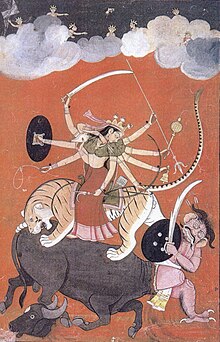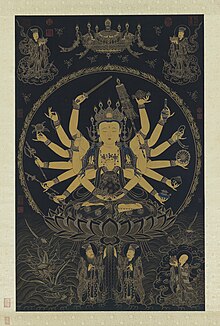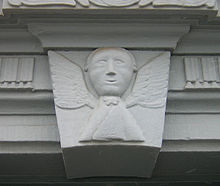Goddess
In some faiths, a sacred female figure holds a central place in religious prayer and worship. For example, Shaktism (one of the three major Hindu sects), holds that the ultimate deity, the source of all reality, is Mahadevi (Supreme Goddess) and in some forms of Tantric Shaivism, the pair of Shiva and Shakti are the ultimate principle (with the goddess representing the active, creative power of God). Meanwhile, in Vajrayana Buddhism, ultimate reality is often seen as being composed of two principles depicted as two deities in union (yab yum, "father-mother") symbolising the non-duality of the two principles of perfect wisdom (female) and skillful compassion (male).[2]
Polytheist religions, including Polytheistic reconstructionists, honour multiple goddesses and gods, and usually view them as discrete, separate beings. These deities may be part of a pantheon, or different regions may have tutelary deities.
Etymology
The noun
Historical polytheism
Ancient Near East
Mesopotamia
Ancient Africa (Egypt)
- Goddesses of the
- Goddesses of the Hauhet; originally a cult of Hathor
- Satis and Anuket of the triad of Elephantine
Canaan
Goddesses of the
.Anatolia
- Cybele: Her Hittite name was Kubaba, but her name changed to Cybele in Phrygian and Roman culture. Her effect can be also seen on Artemis as the Lady of Ephesus.
- cult.
- Hittite Empireand monarchy.
- Lykia. She was also the main goddess of the capital city of Lykia League (Letoon)
Pre-Islamic Arabia
In pre-Islamic
According to
The Quran (
Indo-European traditions
Pre-Christian and pre-Islamic goddesses in cultures that spoke Indo-European languages.
Indian
- Ushas: is the main goddess of the Rigveda and is the goddess of the dawn.
- Prithivi: the Earth, also appears as a goddess. Riversare also deified as goddesses.
- Agneya: or Aagneya is the Hindu Goddess of Fire.
- Varuni: is the Hindu Goddess of Water. Bhumi, Janani, Buvana, and Prithvi are names of the Hindu Goddess of Earth.
Iranian
- Anahita: or Anahit, or Nahid, or Arədvī Sūrā Anāhitā, or Aban: the divinity of "the Waters" and hence associated with fertility, healing, beauty and wisdom.
- yazatas, representing insight and revelation, hence "conscience" or "religion".
- Amesha Spentas, a female divinity associated with earth and Mother Nature. She is also associated with the female virtue of devotion (to family, husband, and child). In the Iranian calendar, her name is on the twelfth month and also the fifth day of the month.
- yazatas.[9]
Greco-Roman

- Eleusinian Mysteries: Baubo (goddess of mirth), Demeter (goddess of the harvest) and Persephone (goddess of spring, queen of the Underworld as the wife of Hades).
- Greek muses: Calliope (goddess of epic poetry), Clio (history), Erato (love poetry), Euterpe (music, song, and lyric poetry), Melpomene (tragedy), Polyhymnia (sacred poetry), Terpsichore (dance), Thalia (comedy and pastoral poetry), and Urania (astronomy).
- Aphrodite: Goddess of love and beauty.
- Artemis: Virgin goddess of the wilderness and the hunt.
- Athena: Virgin goddess of strategy, warfare, and crafts.
- Eris: Goddess of chaos.
- Gaia: Primordial goddess of the Earth. Most gods descend from her.
- Hecate: Goddess of sorcery and crossroads. Often considered a chthonic or lunar goddess. She is either portrayed as a single goddess or a triple goddess (maiden, mother, crone).
- Hera: Goddess of womanhood, marriage and childbirth, queen of Olympus as the wife of Zeus.
- Hestia: Virgin goddess of the hearth, domesticity and family.
- Iris: Goddess of rainbows.
- Leto: Titan goddess of childhood.
- Nike: Goddess of victory. She is predominantly pictured with Zeus or Athena and sometimes Ares.
- Selene: Titan goddess of the Moon.
- Rhea: Titan goddess of motherhood.
Celtic
Goddesses and Otherworldly Women in
- Celtic antiquity: Brigantia
- Gallo-Roman goddesses: Epona, Dea Matrona
- Irish mythology: Áine, Boann, Brigid, The Cailleach, Danu, Ériu, Fand and The Morrígan (Nemain, Macha, and Badb) among others.
The Celts honoured goddesses of nature and natural forces, as well as those connected with skills and professions such as healing, warfare and poetry. The Celtic goddesses have diverse qualities such as abundance, creation and beauty, as well as harshness, slaughter and vengeance. They have been depicted as beautiful or hideous, old hags or young women, and at times may transform their appearance from one state to another, or into their associated creatures such as crows, cows, wolves or eels, to name but a few. In Irish mythology in particular, tutelary goddesses are often associated with sovereignty and various features of the land, notably mountains, rivers, forests and holy wells.[10]
Germanic
Surviving accounts of
Pre-Columbian America
Aztec
- Chalchiuhtlicue: goddess of water (rivers, seas, storms, etc.)
- Chantico: goddess of the hearth, flames
- Coyolxauhqui: warrior goddess associated with the moon
- Duality Earth Goddesses: Tlazolteotl(filth and purification)
- Itzpapalotl: monstrous ruler of Tamoanchan(a paradise realm)
- Mictlan(the underworld)
- Xochiquetzal: goddess of fertility, beauty, and female sexuality
Maya
- Ixchel: mother goddess
- Maya moon goddess
- Goddess I: eroticism, human procreation, and marriage
Inca
- Pachamama: the supreme Mother Earth
- Mama Killa: moon goddess
- Mama Ocllo: fertility goddess
- Mama Cocha: goddess of the sea and lakes
Native North America
Goddesses of various Native North American peoples include:
- Spider Grandmother: Creator goddess of the Southwestern United States
- Atahensic: Iroquois sky goddess
- Atira: Pawnee earth and corn goddess
- Tia: Haida goddess of peaceful death
- Inuitgoddess of the sea and underworld
- Tainomother goddess
Folk religion and animism
African religions
In African and African diasporic religions, goddesses are often syncretised with
A rare example of henotheism focused on a single Goddess is found among the
Chinese folk religion
- Mazuis the goddess of the sea who protects fishermen and sailors, widely worshipped in the south-eastern coastal areas of China and neighbouring areas in Southeast Asia.
- The Goddess Weaver Zhinü, daughter of the Celestial Mother, wove the
Shinto
Goddess
Dharmic Religions
In the
Hinduism

There is much diversity in the
Some traditions posit a dual deity in the form of
In

In the great Shakta scripture known as the Devi Mahatmya
Local deities of different village regions in India were often identified with "mainstream" Hindu deities, a process that has been called Sanskritisation. Others attribute it to the influence of monism or Advaita, which discounts polytheist or monotheist categorisation. While the monist forces have led to a fusion between some of the goddesses (108 names are common for many goddesses), centrifugal forces have also resulted in new goddesses and rituals gaining ascendance among the laity in different parts of Hindu world. Thus, the immensely popular goddess Durga was a pre-Vedic goddess who was later fused with Parvati, a process that can be traced through texts such as Kalika Purana (10th century), Durgabhaktitarangini (Vidyapati 15th century), Chandimangal (16th century) etc.
Widely celebrated
) and spans nine nights of prayer in the autumn, also referred as Sharada Navratri.Buddhism


There are numerous female deities in the various Buddhist traditions.[18] Buddhist goddesses are widely depicted in Buddhist art.[19] Early Buddhism in India venerated various female goddesses. These were mostly considered to be devas or spirits (such as yakshinis). They include Prthivi (earth goddess), Hariti, Lakshmi and Mayadevi (the mother of the Buddha).[20] Some of these figures remain important in Theravada Buddhism today, including Maya and Prthivi (known as Phra Mae Thorani in Southeast Asia).
Indian
In the Mahayana traditions, some are considered to be bodhisattvas (beings advancing on the path to Buddhahood) or full Buddhas, while others are just devas (worldly deities).[19] The most important Buddhist female deities in East Asian Buddhism are the bodhisattva Guanyin and the "mother of Buddhas" Cundi. In Tibetan Buddhism, Tara is the most important female deity (often considered to be a full Buddha).[22]
The tantric dakini Vajrayogini is an important tantric meditation deity (yidam) in Tibetan Vajrayana, and is also considered to be a female Buddha in her own right.[23][22] Tantric Buddhist goddesses were often considered to be fully awakened Buddhas and sometimes are depicted with unique tantric elements, such as skullcups and flaying knives. These tantric deities include Simhamukha, Mahamaya, Vajrayogini, Chinnamunda and Kurukulla.[22]
Mahayana goddesses are often termed "devis" (Sanskrit: devi, "female deity", "goddess", Tibetan: lhamo) or even bhagavani (the female version of bhagavan, indicating Buddhahood).[24]
Abrahamic religions
Judaism
According to
The Zohar tradition has influenced
The following female deities are mentioned in prominent Hebrew texts:
More commonly, modern Judaism acknowledges Shekhinah as the feminine aspect of God.[27][28] Shekhinah is considered to be the presence of God on Earth and/or the spirit of the Jewish people, forever trying to reunite with the other elements of God through tikkun olam.[29] She is also associated with the moon, the earth, David, and Rachel.[30][31]
Christianity

The veneration of
, and other lofty titles.Marian devotion similar to this kind is also found in Eastern Orthodoxy and sometimes in Anglicanism, although not in the majority of denominations of Protestantism. In some Christian traditions (like the Orthodox tradition),
In
Latter Day Saint movement
The members of most denominations in the Latter Day Saint movement believe in, although they do not directly worship, a Heavenly Mother who is the female counterpart of the Heavenly Father. Together they are referred to as Heavenly Parents. Adherents also believe that all humans, both women and men, have the potential to become gods through a process known as exaltation.
Neopaganism
Most
Wicca

In Wicca "the Goddess" is the deity of prime importance, along with her consort the Horned God. Within many forms of Wicca the Goddess has come to be considered as a universal deity, more in line with her description in the
Goddesses or demi-goddesses appear in sets of three in a number of ancient European pagan mythologies; these include the Greek
Robert Graves popularised the triad of "Maiden" (or "Virgin"), "Mother" and "Crone", and while this idea did not rest on sound scholarship, his poetic inspiration has gained a tenacious hold. Considerable variation in the precise conceptions of these figures exists, as typically occurs in Neopaganism and indeed in pagan religions in general. Some choose to interpret them as three stages in a woman's life, separated by menarche and menopause. Others find this too biologically based and rigid, and prefer a freer interpretation, with the Maiden as birth (independent, self-centred, seeking), the Mother as giving birth (interrelated, compassionate nurturing, creating), and the Crone as death and renewal (holistic, remote, unknowable) — and all three erotic and wise.
Feminism
Goddess movement
At least since first-wave feminism in the United States, there has been interest in analysing religion to see if and how doctrines and practices treat women unfairly, as in Elizabeth Cady Stanton's The Woman's Bible. Again in second-wave feminism in the U.S., as well as in many European and other countries, religion became the focus of some feminist analysis in Judaism, Christianity, and other religions, and some women turned to ancient goddess religions as an alternative to Abrahamic religions (Womanspirit Rising 1979; Weaving the Visions 1989). Today both women and men continue to be involved in the Goddess movement (Christ 1997). The popularity of organisations such as the Fellowship of Isis attest to the continuing growth of the religion of the Goddess throughout the world.
While much of the attempt at gender equity in mainstream Christianity (Judaism never recognised any gender for God) is aimed at reinterpreting scripture and degenderising language used to name and describe the divine (Ruether, 1984; Plaskow, 1991), there are a growing number of people who identify as Christians or Jews who are trying to integrate goddess imagery into their religions (Kien, 2000; Kidd 1996,"Goddess Christians Yahoo Group").
Sacred feminine
The term "sacred feminine" was first coined in the 1970s, in New Age popularisations of the Hindu Shakti. Hinduism also worships multitude of goddesses that have their important role and thus in all came to interest for the New Age, feminist, and lesbian feminist movements.[34]
Metaphorical use
The term "goddess" has also been adapted to poetic and secular use as a complimentary description of a non-mythological woman.
Shakespeare had several of his male characters address female characters as goddesses, including Demetrius to Helena in A Midsummer Night's Dream ("O Helen, goddess, nymph, perfect, divine!"), Berowne to Rosaline in Love's Labour's Lost ("A woman I forswore; but I will prove, Thou being a goddess, I forswore not thee"), and Bertram to Diana in All's Well That Ends Well. Pisanio also compares Imogen to a goddess to describe her composure under duress in Cymbeline.
See also
- Anima (Jung)
- Gavari
- Gender of God
- Goddess movement
- Heavenly Mother
- List of goddesses
- Matriarchy
- Mother goddess
- Ochre
- Oshun
- Sophia
- The Myth of Matriarchal Prehistory
- The White Goddess
- Tree deity
- Venus figurines
References
- ISBN 978-1438110387. Text: goddesses Female deities.
- ISBN 978-0-8348-2842-1. Retrieved 18 January 2020.
- incomplete short citation]
- ISBN 0-06-090854-8.
- ^ Sylvia Brinton Perera, Descent to the Goddess (Toronto 1982) re Inanna and Ereshkigal.
- ISBN 978-0313294976.
- ^ Collins, Paul (1994). "The Sumerian Goddess Inanna (3400-2200 BC)". Papers of from the Institute of Archaeology. Vol. 5. UCL. pp. 110–111.
- Sale's Text, Preliminary Discourse, and Notes. London: Kegan Paul, Trench, Trubner, and Co.
- ^ Taheri, Sadreddin (2014). "Goddesses in Iranian Culture and Mythology". Tehran: Roshangaran va Motale’at-e Zanan Publications.
- ISBN 9781903296264.
- ^ Relke, RJ (2001). "CHAPTER 4: THE AFRICAN NILOTIC PEOPLES AS ETHNOGRAPHIC PARALLELS: FINDING THE RIGHT "FIT": AN APPROPRIATE ETHNOGRAPHIC PARALLEL". UNE. 25-32. Retrieved 2 January 2024.
- ISBN 9780435940027.
- ISBN 1439106495. Retrieved 22 April 2016.
- ^ "Amaterasu". World History Encyclopedia. Retrieved 21 February 2019.
- ISBN 0-520-06339-2.
- ^ Thomaskutty, Johnson. ""Glimpses of the 'Feminine' in Indian Religion and Society: A Christian Perspective" by Johnson Thomaskutty": 81.
{{cite journal}}: Cite journal requires|journal=(help) - ISBN 978-81-250-1438-6.
- ^ for a full overview and list of goddesses see: Shaw, Miranda (2006). Buddhist Goddesses of India, Princeton University Press.
- ^ a b "| Wisdom, Compassion and Wrath: The Many Faces of Female Buddhist Deities – Intern Exhibition OnlineRuth Chandler Williamson Gallery". rcwg.scrippscollege.edu. Retrieved 16 November 2023.
- ^ Shaw, Miranda (2006). Buddhist Goddesses of India, pp. 5-6. Princeton University Press.
- ^ a b Shaw, Miranda (2006). Buddhist Goddesses of India, pp. 6-7. Princeton University Press.
- ^ a b c Shaw, Miranda (2006). Buddhist Goddesses of India, p. 8. Princeton University Press.
- ^ "Female Power in the Himalayas | Rubin Museum of Art". rubinmuseum.org. Retrieved 16 November 2023.
- ^ "Subject: Goddess Terminology (Devi)". www.himalayanart.org. Retrieved 16 November 2023.
- ^ "Samael & Lilith - Unexplained - IN SEARCH FOR TRUTH". rin.ru.
- ISBN 0195358708.
- ^ "Shekhinah: The Divine Feminine". My Jewish Learning. Retrieved 2 January 2024.
- ^ "Shekhina | Divine Presence, Feminine Aspect, Holiness | Britannica". www.britannica.com. Retrieved 2 January 2024.
- ^ Freeman, Tzvi (2014). "Who Is Shechinah, And What Does She Want from My Life?". Chabad. Retrieved 2 January 2024.
- ^ "Ten Sefirot: Shekhinah, Malkhut". www.jewishvirtuallibrary.org. Retrieved 2 January 2024.
- ^ "The Shekhinah | telshemesh.org". www.telshemesh.org. Retrieved 2 January 2024.
- ^ "Redemptoris Mater (25 March 1987) | John Paul II". www.vatican.va. Retrieved 2 January 2024.
- Böhme, Jacob (1622). The Way to Christ. William Law (trans.). Pater-noster Row, London: M. Richardson.
- ISBN 9780520908833. Retrieved 22 April 2016.
goddess.
- incomplete short citation]
Further reading
- Beavis, Mary Ann and Helen Hye-Sook Hwang (eds). Goddesses in Myth, History and Culture, Mago Books, 2018. ISBN 1976331021
- Dexter, Miriam Robbins, and Victor Mair (2010). Sacred Display: Divine and Magical Female Figures of Eurasia. Cambria Press.
- Barnhart, Robert K (1995). The Barnhart Concise Dictionary of Etymology: the Origins of American English Words. ISBN 0-06-270084-7
- Gorshunova . Olga V.(2008), Svjashennye derevja Khodzhi Barora…, ( Sacred Trees of Khodzhi Baror: Phytolatry and the Cult of Female Deity in Central Asia) in Etnoragraficheskoe Obozrenie, n° 1, pp. 71–82. ISSN 0869-5415. (in Russian).
- Taheri, Sadreddin (2014). Goddesses in Iranian Culture and Mythology. Tehran: Roshangaran va Motale’at-e Zanan Publications. ISBN 9789641940821.
